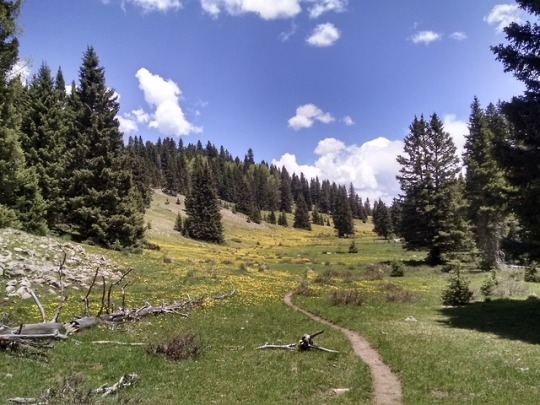By James Lautzenheiser

An old beaver dam along the Rio Puerco
In Rio Arriba county, New Mexico State Highway 96 is a bit of a dividing line between two special Wilderness areas. They each have a lot of water, but that water manifests itself very differently in each location. While these areas may be separated by the 96 corridor (about 10 miles), they are joined by footpaths (Continental Divide Trail), waterways (Rio Gallina), and administrative units (both are partially in the Coyote Ranger District of the Santa Fe National Forest). Access to one involves hiking up, while the other it generally involves hiking (or floating) down. The high point of one is approximately the same as the low point of the other. I am talking, of course, about San Pedro Parks Wilderness and Chama River Canyon Wilderness!

The defining quality of San Pedro Parks is, perhaps, its 10,000 foot high plateau full of open, rolling, park-like meadows (that give it part of its name), which are punctuated by exclamations of tree-covered hilltops, beaver-tempting streams, and a selection of exposed geology. The meadows are kept open and grassy not by the activities of humans, but by the time and place they exist. San Pedro Parks is very wet, with some of the most precipitation in the state. While much of this is snow, the monsoon season is not afraid to share some summer moisture, also. All this leads to wet, bog-like meadows that form numerous rivulets, collecting into larger runs such as Rio Puerco (which eventually joins the Rio Grande south of Albuquerque), with these runs draining out of San Pedro Parks in all directions, providing surrounding communities with high quality water. The quantity of water is high enough that there exists collection and retention devices from the pre-Wilderness days, such as reservoirs and acequias.

Instead of having water flow out, the Chama River Canyon Wilderness has water flowing in, although it’s mostly through. As its name suggests, there is a canyon present, through which the Rio Chama flows. What’s more is that there are dozens of canyons of varying sizes. Of the two trails in this wilderness, both interact heavily with canyons. The vast majority of people who go through Chama River Canyon Wilderness go on a float trip down the Rio Chama and through the Chama River Canyon itself. The Rio Chama is perennial, with flow controlled by a dam since 1933. The dam is opened more so on the weekend, leading to bigger waters. This experience offers sights and sounds that cannot easily be experienced in any other way. In fact, the only way to access this area of the river canyon other than boat is to make an attempt at hiking down one of the numerous canyons leading from the mesa, off the rim of Chama Canyon. By midsummer, nearly all these canyons are parched, with water only near the source spring. Often, the nearby presence of water is announced not by sound and presence of itself, but by the sound and presence of mosquitos and other water-loving insects. Closer in, we find reeds, grasses, and other plants that are generally absent in the surrounding terrain. Time to restock the canteen! This is desert country, and once past these watering holes, the next water may be the Rio Chama several miles away.

So close, so far away. The Rio Gallina leaves San Pedro Parks Wilderness flowing strongly, we could cross it on foot but probably not stay dry. In midsummer, by the time it reaches the Rio Chama it is a muddy riverbed with little to no flow. The Continental Divide Trail works around cottonwoods, cacti, and cliffs in Chama River Canyon Wilderness, while users enjoy many moist mountain meadows in San Pedro Parks. Back along Highway 96, summer storms bring flashes and the possibilities of rain all around the Coyote Ranger District, but we know more will fall in San Pedro Parks. What really connects these two areas is their Wilderness designation, reinforcing the importance they have locally, regionally, nationally, even globally. To be able to find such proximal diversity is truly amazing, and worth providing protection for.

James works for New Mexico Wilderness Alliance as a Wilderness Ranger on the Santa Fe National Forest in San Pedro Parks and Chama River Canyon Wilderness areas. For questions about these areas, volunteering, the Forest, or NMWA, consider emailing James at james@nmwild.org

